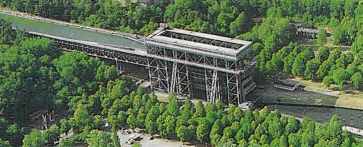
The Hohenzollern Canal (now the Oder-Havel-Canal) was built from 1907 to 1914; at the same time, a second decent was already planned in 1905. The decent was made possible at that time - downwards to the Oder and Baltic Sea, upwards in the direction of the Havel and the Elbe - by the use of locks, which were north of the present ship lift. The locks consisted of 4 chambers, which at that time spanned an elevation of 9 m and were designed for ships under 600 t. Each lock required about 2 hours, and that was, especially through the industrial development, too expensive and not very practical. The ship lift was built 55 km north-east of Berlin from 1927 to 1934 in accordance with plans of K. Plarre as a bypass of the locks. Extensive preparation preceeded the construction. The idea was tested with a model which was a fifth of the actual size. The commission was given to several distinguished firms, which were joined together in a common account. For the construction, the removal of 760,000 cubic meter of earth was required; 72,000 cubic meter of concrete and 13,800 tons of steel (St 52 steel for the trough) were used. The construction cost 27.5 million Reichsmark.
|
The lift is comprised of a lower dock, the lift itself, a canal bridge, and an upper dock with an emergency gate. The upper dock has a length of 1200 m; the canal bridge is 157 m long. At the end of the bridge is the emergency gate, which can be quickly closed by remote control. The ship lift has a total length of 94 m. It is 60 m high; the trough into which the ships sail has a length of 85 m, the width is 12 m, and the water is 2.5 m deep. Its weight amounts to 4300 t and it can service ships up to 1000 t. To compensate for the weight there are 192 counterweights just as heavy as the trough with water and load. The consist of concrete and iron connectors and hang on cables (256 wire-ropes with a diameter of 52 mm, first replaced in 1984) which run over pulleys in the top of the ship lift (diameter of 3.5 m with a weight of about 5 t). With every trip of the lift, 12 cm per second, the balance of the trough and weights changes around the shortening and lengthening of the relative lengths of the cables on both sides of the pulleys. This results in a weight difference of 90 t when the trough is located at the top or bottom. Compensating chains balance the weight at these times. Through this principle gravity is economically used; the ship lift is only equipped with four 75 hp strong motors. The only forces that need to be overcome are friction and the inertia of the trough and weights. A system of shafts and gears ensure that all 4 motors pull with exactly the same force. If one motor fails, the trough does not fall diagonally, but is evenly pulled. |
 |
The principle of raising and lowering is rather simple. The ship sails into the trough which is sealed to the canal with the help of presses and a special construction of a seal - so tightly, in fact, that the wet lifting chamber becomes part of the canal. At a signal the gates of the trough and of the canal raise at the same time around the ship and the load. The entire event (lifts the ship 36 m) lasts about 20 minutes, including the opening and closing of the gates.
With around 40 maneuvers the day, the wet needle's eye can just barely overcome the lively arrival of traffic on the waterway. The construction of a second lift is therefore alredy being planned. First, however, the old locks will be reconstructed in order to develop a further tourist attraction.
The 10 predecessors of the Niederfinow ship lift:
All predecesors work with water filled troughs hanging from wire-ropes or chains.
- Grand Western Canal (connection the Themse with the Severn, England): wooden trough on chains, counterweight is a second trough, planned 1796, built 1838, length 9 m, load 8 tons, height 14 m
- Anderton (England): 2 independent troughs on cables, hydraulic movement, built 1875, re-built 1906, load 100 tons each, height 15.1 m
- Canal de Neufossé (Les Fontinettes, Northern France): built 1888, height 13 m, load 300 t
- Canal du Centre (La Louviére, Belgium): with pressing cylinders, after 1888, load 400 t
- Trent Canal (connecting the Ontario Lake with the Huron Lake, Canada): 2 ship lifts, mass 1700 t, height 14.8 m and 19.8 m
- Canal du Centre (Belgium): three more ship lifts, built 1908-1917, load 300 t
- Dortmund-Ems-Kanal (Henrichenburg, Germany): floating principle, built 1895, 5 30m-deep wells with a floating body 9.2 m in diameter, mass 3000 t
Not a lift, but...
in Belgium: The Ronquières inclined plane (with animated picture)
Tours through the shiplift
Tour 1: from the upper canal down and up again (1.5 hours, 10 DM)
Tour 2: from Oderberg up the shiplift, down and back to Oderberg (3.5
hours, 18 DM)
